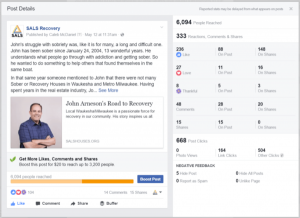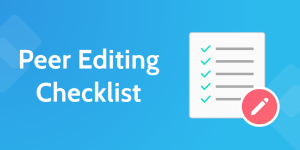— September 11, 2018
If you rely on search engine traffic, conversion optimization starts before visitors get to your site. Why? Sitelinks.
For most sites, a brand query (e.g. “king arthur flour”) generates sitelinks—links from other pages on your site that appear below the main link, typically the homepage. For mobile searches, those sitelinks may be expandable, allowing users to browse multiple levels of your site, all before clicking a link.
These potential shortcuts can streamline the user experience and get visitors to the places they want to go—and the places you want them to go—faster. After all, how many users accomplish their goal on your homepage?
Yet few know:
- which sitelinks show up for their site;
- how their sitelinks have changed over time;
- why they may have changed; or
- how they can influence the sitelinks that appear.
If you want answers, keep reading.
Why sitelinks matter for conversions
Google’s own research has shown that, compared to non-branded keywords, brand keywords have a 2x higher conversion rate. Supporting research also shows that brand queries consistently deliver higher conversion rates.
That conclusion aligns with intuition—searchers using brand keywords already have brand awareness and, presumably, brand affinity—and also underscores the importance of a great user experience for those visitors.
When a brand search generates sitelinks, some of your most qualified users are choosing their next step based on those options. Taking good care of them can have a disproportionate impact on your leads and sales compared to optimizations that target non-branded queries.
Neglecting those visitors, on the other hand, may cost you easy sales.
How do search engines choose sitelinks?
Sitelinks appear below the main link for a “navigational” query, or “one in which the user is looking for a specific web site, rather than information from a web page.” About 18% of all queries qualify as navigational queries. Most navigational queries are explicit brand queries.
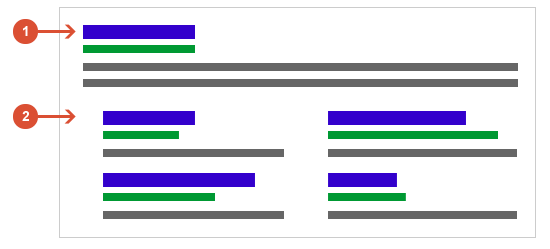
The main link (1) and its (2) sitelinks. (Image source)
According to Google, sitelinks are “shortcuts that will save users time and allow them to quickly find the information they’re looking for.” Bing refers to sitelinks as “popular destinations,” or pages where users typically end up after entering a website.
Importantly, sitelinks are not merely a cache of popular pages: “The destinations may not be among the topranked results, may not contain the queried terms, or may not even be indexed by the search engine.”
So how are they chosen? Sitelinks are generated algorithmically. Bill Slawski, who monitors search engine patents, summarizes the likely factors:
- How many times the page has been accessed
- How long visitors stayed upon the page
- If a visitor scrolled down the page, or clicked on a link, without scrolling down
- Information retrieval scores for the page, along with an indication of how good a match the page may be for the query that was used in the search
- The likelihood that someone might make a purchase on that page
- Other information that might indicate that someone would be interested in the page
Until 2016, site owners could use Google Search Console (GSC) to “demote” sitelinks—blocking irrelevant pages from appearing as sitelinks for 90 days. Bing still allows site owners to block “deep links” in its Webmaster Tools.
How are sitelink labels chosen?
Even if the ideal sitelinks are chosen, the labels for those sitelinks may be uninformative or misaligned with the content of the page.
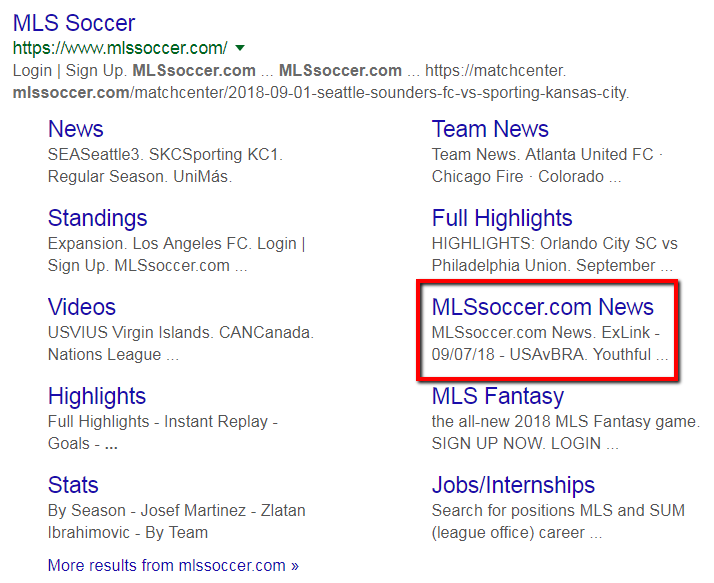
Confusingly, Major League Soccer’s website has three sitelinks with a “news” label, including their RSS feed.
As Yahoo confirms, accurate, informative labels are vital to earning clicks:
Eye-tracking studies have shown that search engine users focus a lot of their attention on the link title of the results, paying even more attention to the link title than to the summary provided along with the result.
Ultimately, sitelink labels are chosen based on several factors. Again, Bill Slawski summarizes potential factors based on patent filings:
- Anchor text pointing to the page from internal or external links
- Search queries for which the page was returned as a result, especially if it was the first result or among the top ten
- Search queries for which the page was clicked upon from search results
- Key phrases extracted from social bookmarking tags
The ongoing rise of mobile search has made sitelinks and their labels increasingly important.
Why sitelinks are critical for mobile conversions
Google introduced sitelinks in 2006. Initially, they appeared for only the first result of a navigational query and only underneath a site’s homepage.
Over the past decade, Google has rolled out a number changes, such as one-line sitelinks below multiple results and sitelinks for pages other than the homepage. Yet for conversions, the most important change—expandable sitelinks—has happened on mobile.
Expandable sitelinks—initially tested in 2017 and later rolled out on a larger scale—allow users to browse a website directly from search results, potentially navigating through multiple levels before clicking a link:
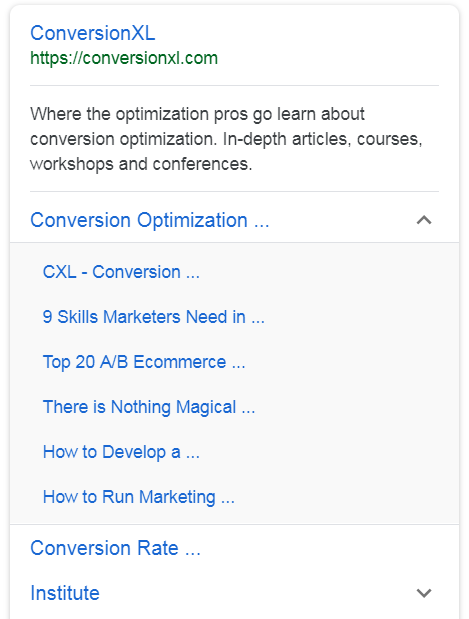
Getting expandable mobile sitelinks hinges, in large part, on a consistent site structure.
For ecommerce sites, a clear, consistent hierarchy is vital. REI, which gets 1.9 million monthly brand queries according to Ahrefs data, reveals what can happen if you don’t get it right:
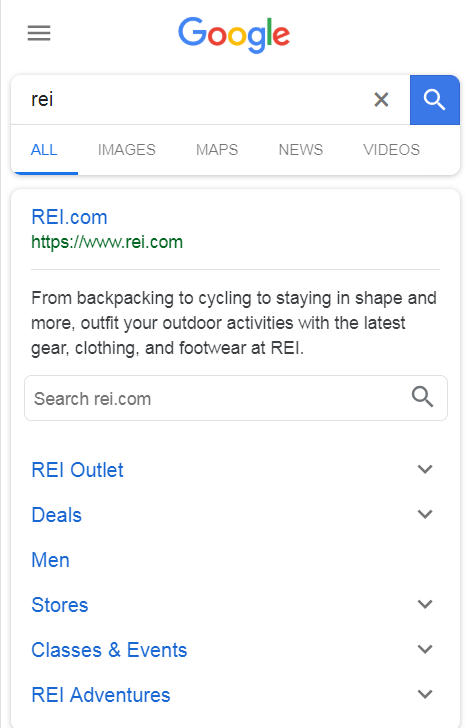
First, if you’re looking for women’s clothes, there’s no sitelink. Second, if you’re shopping for men’s goods, there’s no expandable sitelink menu to refine your choice. And it’s not as though REI doesn’t have pages for various types of menswear:
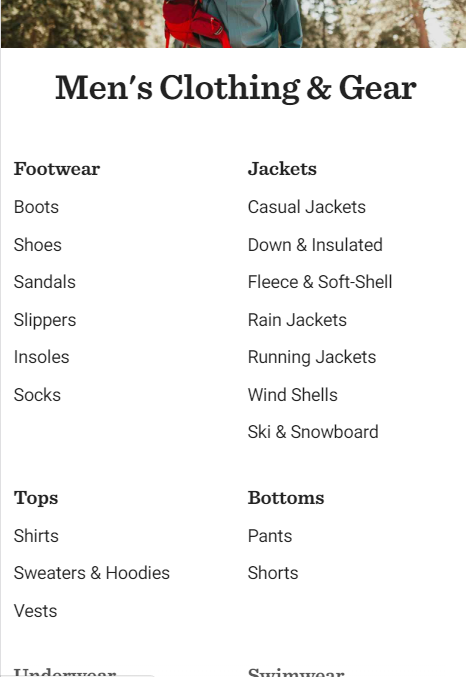
However, those pages are part of a flat site architecture rather than a nested, hierarchical structure:
Men’s clothing sitelink URL:
https://www.rei.com/h/mens-clothing
Sample product category URLs:
https://www.rei.com/c/mens-boots
https://www.rei.com/c/mens-casual-jackets
https://www.rei.com/c/mens-pants
The lack of a hierarchy weakens search engine connections between the top-level page and product categories, preventing that section from earning expandable sitelinks.
In contrast, the Classes & Events page includes individual locations behind the main URL:
Classes & Events sitelink URL:
https://www.rei.com/events
Individual location URLs:
https://www.rei.com/events/p/us-ga-atlanta
https://www.rei.com/events/p/us-ca-los-angeles
https://www.rei.com/events/p/us-wa-seattle
Sure enough, the top-level category receives expandable sitelinks:
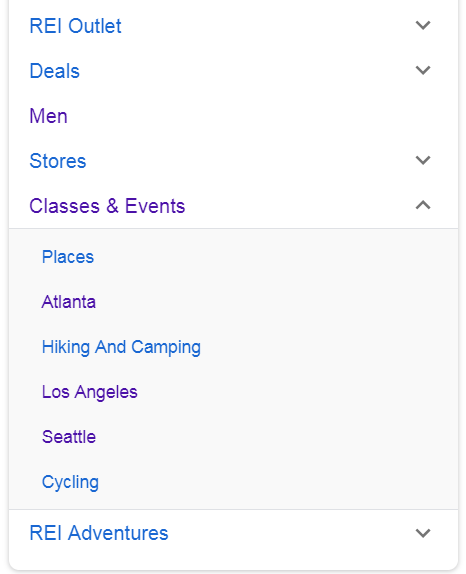
For REI, an inconsistent site structure puts unnecessary clicks between mobile shoppers and a sale. (Those looking for women’s gear have no choice but the homepage.)
Of course, you won’t be able to diagnose or resolve these issues unless you know which sitelinks appear for your brand.
How to identify sitelinks for your brand
Beyond the anecdotal (and “personalized”) evidence you may uncover in a self-search, how much do you know about which sitelinks appear for your site?
GSC provides an easy way to see which sitelinks show up. First, filter queries to include only brand queries:
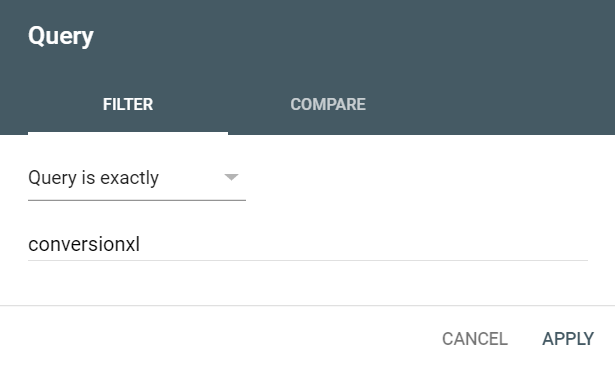
Depending on your brand name, you may need to use “Queries containing” rather than “Query is exactly” (especially if your brand name has multiple words, is frequently misspelled, or includes geographic modifiers). It’s impossible to capture every brand query, but filtering for most is sufficient.
GSC provides up to 16 months of data. Choose whichever time period you’re most interested in (and compare results over time, something covered in the next section).
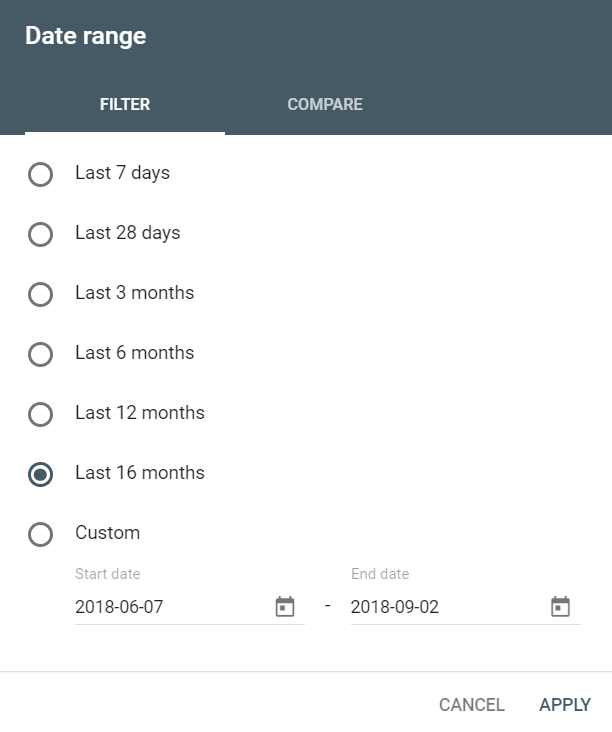
From there, navigate below to the “Pages” tab and filter “Position” by “Smaller than 1.5.” This limits the data to instances when pages rank first for brand queries. (GSC reports an appearance as a sitelink as a ranking of 1.)

The resulting list allows you to see your sitelinks for the given time period ordered by impressions (the number of times they appeared) or clicks (the number of times they earned user clicks):
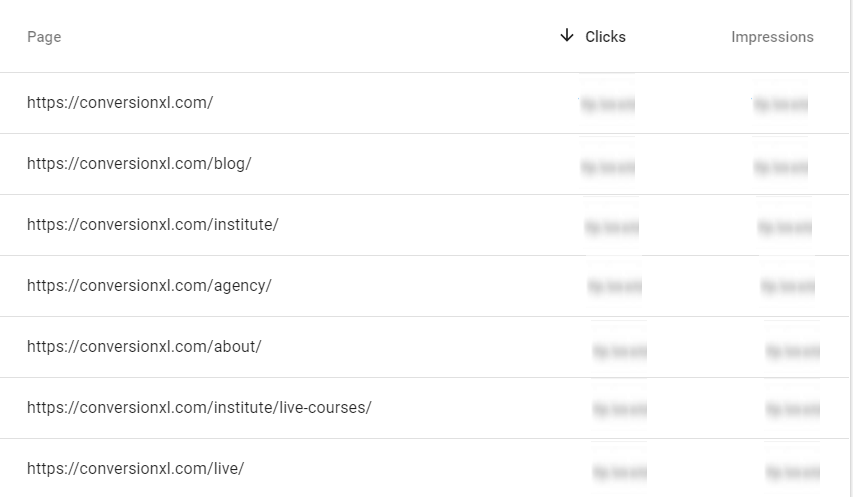
You can also run the same analysis with the Device category set to desktop, mobile, or tablet to determine whether different sitelinks appear for mobile users.
This static portrait, however, is just the beginning.
How to measure changes to sitelinks
Exporting month-by-month or quarter-by-quarter data from GSC—using the same parameters identified in the previous section—can show how sitelink visibility has changed over time. This is particularly useful to determine how changes to your site affect changes to your sitelinks.
Divide the number of impressions for each page by the number of impressions to the homepage. The resulting percentage shows how often each page shows up as a sitelink. For example, if a services page has 20,000 impressions and the homepage 40,000, the services page shows up as sitelink 50% of the time.
For CXL, the Agency, Institute, and Blog pages have appeared as sitelinks nearly 100% of the time over the last year, with the About page trailing just behind. The remaining sitelinks have appeared more recently:
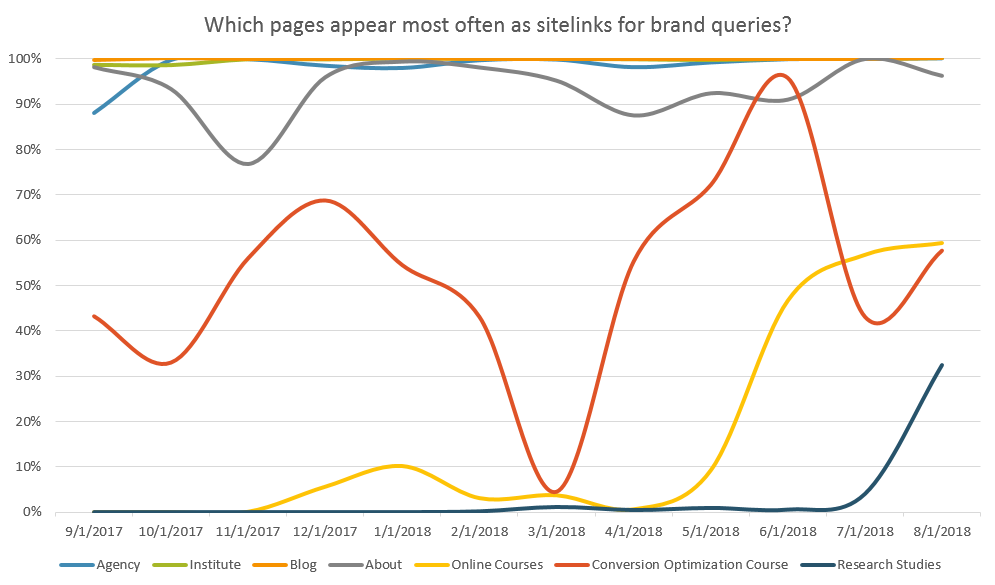
(Certainly, other pages have appeared—and disappeared—over time. To create a cleaner chart, I’ve included only the seven pages that currently appear most often as sitelinks.)
Similarly, you can chart the percentage of clicks that have gone to each sitelink. Simply divide the number of clicks to a given page by the total number of clicks to any page on the site:
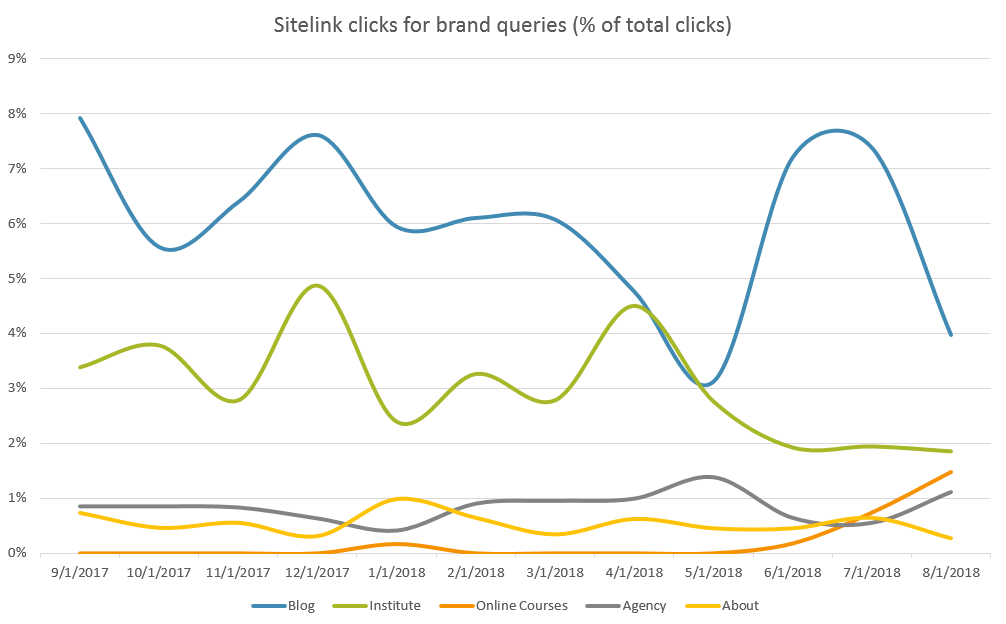
These charts reveal where brand-query users go first on our site. If 4–8% of users searching for “conversionxl” enter through the blog, the blog landing page—a de-facto homepage for some of our highest-value users—needs enough information to engage those visitors.
While the above sitelinks make sense for CXL, what happens if your sitelinks fail to include key pages or list irrelevant ones?
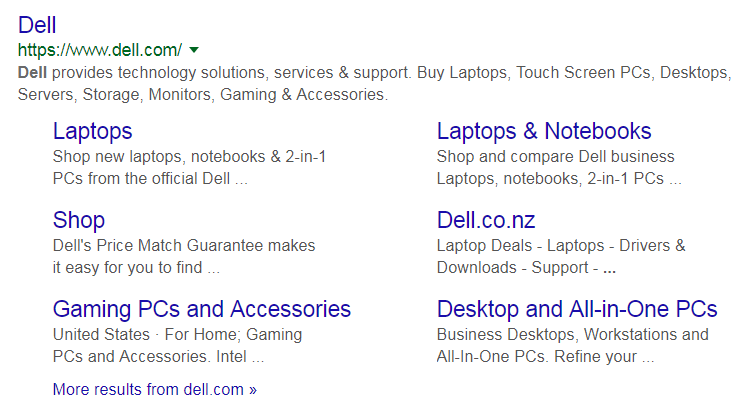
A sitelink for Dell’s New Zealand site is a wasted opportunity to streamline a user experience. (I’m more than 10,000 miles away.)
Jobs pages are a regular offender. If you’re not desperate to hire and you syndicate your job listings through other sites, there’s no reason to take up valuable real estate with a page whose presence relies on signals from non-customers:
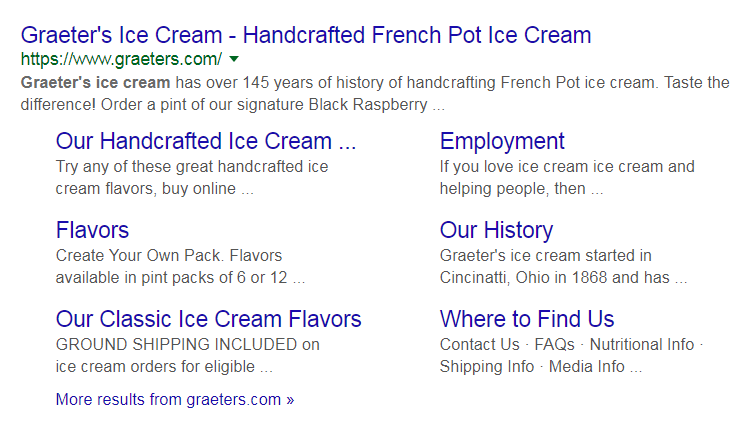
Jobs pages have tons of user signals—but low ROI—for brand queries.
If your sitelinks aren’t tailored for key visitors—for any reason—there are things you can do.
How to improve sitelinks for your site
Many search signals affect which sitelinks appear and which labels identify them. As Google noted in 2011:
From a ranking perspective, there’s really no separation between “regular” results and sitelinks anymore.
Existing best practices for the link structure of your site are still relevant today, both for generating good quality sitelinks and to make it easier for your visitors.
Thus, no single optimization can guarantee changes to sitelinks. But you’re not helpless, either.
Google’s advice to improve sitelinks highlights a few standard SEO best practices:
- Provide a clear structure for your website, using relevant internal links and anchor text that’s informative, compact, and avoids repetition.
- Allow Google to crawl and index important pages within your site. Use Fetch and Render to check that they can be rendered properly.
- If you need to remove a page from search completely, use a “noindex” robots meta tag on that page.
Another post from Google harps on the importance of site and page structure, going so far as to advocate a table of contents to generate “in-snippet” sitelinks that take users directly to sections of multi-topic pages:
Ensure that long, multi-topic pages on your site are well-structured and broken into distinct logical sections. Second, ensure that each section has an associated anchor with a descriptive name (i.e., not just “Section 2.1”), and that your page includes a “table of contents” which links to the individual anchors.
Those recommendations about the importance of page structure apply beyond in-snippet links—just as pages contain sections, subdirectories contain pages, and websites contain subdirectories.
Given the rise of expandable sitelinks for mobile search, the importance of a clear, hierarchical site structure will only increase—users may navigate through multiple subdirectories on a search results page before they click a link. (Or, if they don’t find what they need, not click at all.)
In addition to a clear, hierarchical site structure, there are other options for improvement.
Additional ways to influence the sitelinks for your site:
- Own your brand name. Obviously, this recommendation isn’t feasible for established brands, but those choosing a new brand name should avoid direct competition with other sites. If search engines don’t identify a query for your brand as a navigational query, they’re unlikely to return sitelinks.
- Set irrelevant pages to “noindex.” Use a “noindex” tag to keep low- or no-value pages (such as a privacy policy or jobs page) from appearing as sitelinks. Do so cautiously: Some pages that are poor sitelinks may still have valuable search signals—such as backlinks—that a “noindex” tag casts aside.
- Develop a robust internal linking structure. Internal links should reinforce your site structure—parent pages link to child pages, child pages link back to parent pages, and so on.
- Choose informative, semantically varied anchor text. Anchor text is an opportunity to include descriptive text that helps search engines understand the content of a linked page. Those anchors, when consistent but not identical (i.e. synonyms), may also help search engines determine which text to include for a sitelink label.
- Earn backlinks to deep pages. Most sites are “top heavy” with links from other sites pointing primarily to the homepage. Deep links that point to interior pages help build the authority of those pages, making it more likely that search engines will include them as sitelinks.
Ways to increase user engagement and conversions from sitelink clicks:
- Ensure that sitelinks that are “de-facto homepages” engage visitors. Treat your most common sitelinks as de-facto homepages: They should make a good first impression and include relevant internal links to move visitors through your site. Avoid dead-end “About Us” pages that don’t encourage visitors to explore product or service pages after learning about your organization.
- Make sure you have a coupon or sale page. Coupon, discount, and sale queries usually include a brand name (e.g. “aftershokz coupons”), qualifying them as a navigational search. Even if you don’t offer coupons, a targeted page explaining your policy may show up as a sitelink underneath the homepage for generic brand queries. That sitelink may bring more ready-to-buy clicks to your domain versus the third-party coupon sites below it.
Conclusion
Search engine users typing in a brand query are some of the most valuable users for a site. Yet they’re often ignored—relegated to the homepage or offered a selection of algorithmically curated pages that fail to differentiate between a job seeker and a paying customer. Mobile searchers may even browse sections of a website directly in search results.
Google Search Console provides the data that site owners need to identify sitelinks and monitor changes over time. Those insights can help measure the impact of efforts to put the most relevant, high-value sitelinks in front of brand searchers.
That, in turn, gets more users to their destination pages faster, making conversions quicker and easier—and making websites more profitable.
Digital & Social Articles on Business 2 Community
(140)
Report Post




